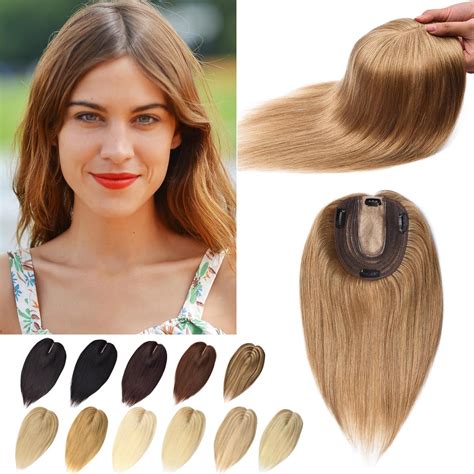Are you struggling with hair loss and seeking a discreet and effective solution? Hair toppers are an innovative way to enhance your appearance and regain your confidence. This comprehensive guide will provide you with all the essential information you need to make an informed decision about hair toppers.

What are Hair Toppers?
Hair toppers are non-surgical hairpieces designed to add volume, length, and coverage to thinning or balding areas of the scalp. They are typically made from high-quality human or synthetic hair and are available in various colors, textures, and styles to match your natural hair.
Benefits of Hair Toppers
- Instant Volume and Coverage: Hair toppers offer immediate results, adding fullness and hiding thinning areas.
- Natural Look: When properly matched and applied, hair toppers blend seamlessly with your own hair, creating a natural appearance.
- Non-Surgical: Unlike hair transplants or other surgical procedures, hair toppers are non-invasive and require no downtime.
- Comfortable and Convenient: Modern hair toppers are designed to be lightweight and easy to wear. They can be removed and reattached multiple times without damaging your hair.
- Versatile Styles: Hair toppers come in a wide range of styles, from short bobs to long layered cuts. You can choose a topper that complements your face shape and personal style.
How to Choose the Right Hair Topper
- Determine Your Hair Loss Pattern: The type of hair topper you choose will depend on the pattern and extent of your hair loss. Consult with a hair loss specialist or stylist to identify the best option for your needs.
- Match Your Hair Color and Texture: To achieve a natural look, it’s crucial to find a hair topper that closely matches your own hair color and texture. Bring a sample of your hair to a hair loss clinic or store for a color and texture consultation.
- Consider Your Head Size: Hair toppers are available in various base sizes to fit different head circumferences. Measure your head circumference before ordering a topper to ensure a comfortable fit.
- Choose the Right Base Material: Hair toppers are available with different base materials, including lace, monofilament, and a combination of both. Lace bases provide a more natural invisible look, while monofilament bases are more durable and cost-effective.
- Set a Budget: Hair toppers can vary in price depending on the materials used, the size, and the complexity of the design. Determine your budget before making a purchase to narrow down your options.
How to Apply Hair Toppers
- Prepare Your Hair: Wash and dry your hair thoroughly before applying the topper. Avoid using heavy styling products, as they can interfere with the adhesive that holds the topper in place.
- Apply Adhesive: Apply a thin layer of hair topper adhesive to the base of the topper. Follow the manufacturer’s instructions regarding the type of adhesive and the drying time.
- Position the Topper: Place the topper over the thinning area and gently press it down to secure it. Use a mirror to ensure that it is positioned correctly.
- Secure the Topper: Apply pressure to the edges of the topper to ensure a secure hold. You can also use hair clips or bobby pins for additional support.
- Style and Blend: Style your own hair around the topper to blend it in seamlessly. Use a hairbrush or comb to create a natural look.
Maintenance and Care
- Regular Cleaning: Wash your hair topper with a mild shampoo and conditioner every two to three weeks. Avoid harsh chemicals or excessive heat styling.
- Proper Storage: When not in use, store your hair topper in a cool, dry place away from direct sunlight. Avoid storing it in plastic bags, as this can trap moisture and damage the hair.
- Professional Maintenance: Visit a hair salon for regular maintenance, including cleaning, conditioning, and color touch-ups. A professional can also help you adjust the fit and style of your topper as needed.
Frequently Asked Questions
1. Are hair toppers noticeable?
When properly applied and matched to your own hair, hair toppers are designed to blend seamlessly and remain virtually undetectable.
2. How long do hair toppers last?
The lifespan of a hair topper depends on the quality of the materials used and how well it is maintained. With proper care, a well-made hair topper can last up to two years.
3. Can I wear a hair topper with a ponytail or bun?
Yes, many hair toppers are designed to be worn with different hairstyles, including ponytails and buns. Consult with a hair specialist to find a topper that meets your styling needs.
4. Are hair toppers suitable for all hair types?
Hair toppers are generally suitable for all hair types, including thin, fine, thick, or coarse hair. However, it’s important to choose a topper that is compatible with your hair texture for a natural look.
5. Can hair toppers damage my hair?
When applied correctly, hair toppers should not damage your hair. However, it is crucial to avoid over-adjusting or using excessive force when securing the topper.
6. Are hair toppers covered by insurance?
Insurance coverage for hair toppers varies depending on your individual policy and the reason for your hair loss. It’s recommended to contact your insurance provider for more information.
Conclusion
Hair toppers offer an effective and non-surgical solution for individuals struggling with hair loss. By following the guidance provided in this guide, you can choose and apply a hair topper that enhances your appearance, boosts your confidence, and meets your individual needs. Remember to consult with a hair loss specialist or stylist for professional advice and support throughout your hair topper journey.
